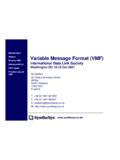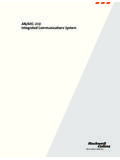Transcription of VARIABLE MESSAGE FORMAT (VMF) - Home - SyntheSys
1 About SyntheSys SyntheSys provides defence systems, training, systems and software engineering and technical management services over a spectrum of different industry sectors. Along with distinct support and consultancy services, our innovative product range makes us first choice provider for both large and small organisations. Established in 1988, the company focus is on fusing technical expertise with intuitive software applications to solve common industry challenges. 90501 DDS0401 VARIABLE MESSAGE FORMAT (VMF) Datasheet D A T A S H E E T VMF is one of the J-Series family of Tactical Data Links (TDLs) to which most allied nations are trying to migrate.
2 Unlike the other J-Series TDLs, VMF can be a build it yourself link in that there is no mandated bearer system, and as such it is designed to be transmitted over any bearer. Needless to say, that can, and does, cause significant interoperability problems but all is not lost because in reality 99% of VMF is passed using SINCGARS Combat Net Radios (CNR), Ultra High Frequency (UHF)/HAVEQUICK or Enhanced Position Location Reporting System (EPLRS). VMF's major roles currently include Fire Support, Close Air Support (CAS), Situational Awareness (SA) and the dissemination of orders and intelligence. However, the functionality is continually being increased and VMF may become the first tactical data link to be used to digitise air-to-air refuelling.
3 VMF, as typically used, is controlled by 3 documents: MIL-STD-6017 (VMF) - general rules and K-Series MESSAGE catalogue MIL-STD-2045-47001 MESSAGE header, mandatory for use with VMF messages MIL-STD-188-220 - Combat Net Radio (CNR) protocols VMF uses K-Series messages that are defined in MIL-STD-6017 (VMF). There are well over 100 messages and the catalogue grows continually. They are arranged in a set of 11 Functional Areas (FA) such as Fire Support and Land Combat Operations, but this is only done for convenience rather than use protocols such as are found in Link 16 NPGs. Many of the messages are used across warfare areas, indeed although VMF is typically thought of as a ground force TDL, it will support whatever environment is desired.
4 It is a joint forces Tactical Data Link. MIL-STD-6017 (VMF) describes the MESSAGE structure and provides some limited guidance on VMF use. A VMF Interface Operating Procedures document has been produced to explain how the various VMF system options are used by each nation, service, platform or unit. Each VMF MESSAGE is typically preceded by a MESSAGE header which is defined in MIL-STD-2045-47001. The header is an essential part of the transmission because it contains addressing data, Receipt/Compliance information, classification, precedence, MESSAGE number etc. In MIDS/Link 16, most of this data is found in the messages themselves.
5 Most VMF operations are carried out on SINCGARS, single frequency UHF or HAVEQUICK bearers using MIL-STD-188-220 CNR protocols. The system operates like an Ethernet using open system architecture based on the commercial OSI 7-Layer Model. In essence, the system comprises a network of many low-level Local Area Networks (LANs) connected via routers to larger Wide Area Networks (WANs). Most of the system is Line of Sight and low bandwidth. The system can also use commercial internet protocols and when this is done it forms part of the United States (US) Army's Tactical Internet. MIL-STD-188-220 defines numerous options to provide exactly what is required for any specific scenario.
6 Sadly this optionality comes at a price - potentially reduced interoperability! It follows that network planning is of paramount importance with VMF systems and it is essential that all of the multitudinous options are disseminated to all potential participants in a timely manner prior to operations. The US is content for allied nations to use VMF but the standards defining it will remain under US configuration management for the foreseeable future. Numerous allied countries have shown interest in the VMF, the United Kingdom (UK) being the first, followed by Australia. The UK intends most of its initial use to be for CAS operations and it will equip most of its CAS capable units with the link.
7

